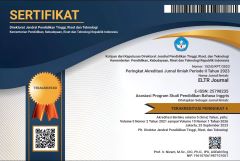FOSTERING LANGUAGE LEARNER AUTONOMY THROUGH THE INVOLVEMENT OF ICT: TEACHERS’ PERCEPTION
Abstrak terlihat: 1158 / PDF terunduh: 938DOI:
https://doi.org/10.37147/eltr.v4i2.66Keywords:
ICT, Learner Autonomy, Teachers’ PerceptionAbstract
Learner autonomy has become a key issue in promoting effective language teaching. Besides, ICT has contributed to the betterment of English language teaching. In fact, there is still limited research which focuses on investigating English teachers’ perception on the use of ICT to promote learner autonomy. This study aimed to investigate the English teachers’ perception on the involvement of ICT for promoting learner autonomy. A Qualitative research design was employed in this study. The data were collected through online questionnaires and interviews. Thirty English teachers were voluntarily involved to participate in this research. The results of the study revealed that the majority of the English teachers saw ICT as an opportunity for them to promote learner autonomy since it helped the students to be more independent and engaged with the lessons. Further research focusing on students’ perspectives about learner autonomy was suggested to enrich the literature of language learner autonomy.
Downloads
References
Artemova, A. (2018). Engaging Generation Z Through Social Media Marketing. Bachelor’s Thesis Business Management. South Eastern Finland, University of Applied Sciences.
Azmi, N. (2017). The Benefits of Using ICT in the EFL Classrooms: From Perceived Utility to Potential Challenges. Journal of Educational and Social Research. Université Cadi Ayyad de Marrakech.
Benson, P. (2001). Teaching and Researching Autonomy in Language Learning. Essex: Pearson Education Ltd.
Borg, S. & Al Busaidi, S. (2012). Learner Autonomy: English Language Teachers’ Beliefs and Practices. ELT Research Paper. London.
Candy, P.C. (1991). Self-direction for Lifelong Learning. California: Jossey-Bass
Çelik, S., Arkin, E., and Sabriler, D. (2012). EFL Learners’ Use of ICT For Self-Regulated Learning. The Journal of Language and Linguistic Studies, 8 (2), 98-118. http://www.jlls.org/vol8no2/98-118.pdf
Chaplin, J.P. (1968). Dictionary of Psychology. New York: Dell Publishing Co. Inc.
Creswell, J. W. (2014). Research Design-Qualitative, Quantitative and Mixed Method Approaches, (4th eds). California: Sage Publication, Inc.
Dafei, D. (2007). An Exploration of The Relationship Between Learner Autonomy and English Proficiency. Asian EFL Journal, The Professional Teaching Articles. https://asian-efl-journal.com/pta_Nov_07_dd.pdf
Darsih, E. (2018). Fostering language learner autonomy: Indonesian EFL lecturers’ voices. English Review: Journal of English Education, 7(1), 51-60.
Dickinson, L. (1987). Self-instruction in Language Learning. Cambridge: Cambridge University Press.
Duong, T. M. (2014). EFL Teachers’ Perceptions of Learner Autonomy and Their Classroom Practises: A Case Study. International Journal of Education and Management Engineering. DOI: 10.5815/ijeme.2014.02.02
Dworkin, S. L. (2012). Sample Size Policy for Qualitative Studies Using In-depth Interviews. Department of Social and Behavioral Sciences. University of California.
Gibson, J.L. (1985). Psychology. Texas: Business Publication Inc.
Holec, H. (1981). Autonomy and Foreign Language Learning. Oxford: Pergamon
Jaiswal, P. (2019). Using Learner-Centered Instructional Approach to Foster Students’ Performances. Journal of Theory and Practice in Language Studies, Vol. 9, No, 9, pp. 1074-1080. DOI: http://dx.doi.org/10.17507/tpls.0909.02
Lacey, F. (2007). Autonomy, never, never, never! Independence, 42, 4-8
Lengkanawati, N. S. (2017). Learner Autonomy in The Indonesian EFL Settings. Indonesian Journal of Applied Linguistics. DOI 10.17509/ijal.v6i2.4847
Little, D. (1991). Learner Autonomy I: Definitions, Issues and Problems. Dublin: Authentik
Little, D., Ridley, J., & Ushioda, E. (2002). Towards Greater Learner Autonomy in the Foreign Language Classroom. Dublin: Authentik
Littlewood, W. (1999). Defining and Developing Autonomy in East Asian Context. Applied Linguistics 20(21): 71-94
Mackey, A. & Gass, S. M. (2005). Second Language Research: Methodology and Design. USA: Lawrence Erlbaum Associates
Penaflorida, A. H. (2002). Nontraditional Forms of Assessment and Response to Student Writing: A Step Toward Learner Autonomy. In Richards, J. C. and Willy A. R. (Eds.), Methodology in language teaching. An anthology of current practice, pp. 344-353. Cambridge: Cambridge University Press.
Pemberton, R. & Mike N. (2012). Practices of Critical Thinking, Criticality and Learner Autonomy. LD SIG Realizing Autonomy Conference Proceedings, Vol 19. Issue 2, July 2012.
Rank, T., Chris W. & Trevor M. (2011). Teaching English Using ICT. New York: Continuum.
Raya, M., Lamb, T., & Vieira, F. (2007). Pedagogy for Autonomy in Language Education in Europe: Towards a Framework for Learner and Teacher Development. Dublin: Authentik.
Saldana, J. (2011). Fundamentals of Qualitative Research. New York: Oxford University Press.
Shadiev, R. Hwang W. & Liu T. (2018). Investigating the Effectiveness of a Learning Activity Supported by A Mobile Multimedia Learning System to Enhance Autonomous Learning In Authentic Contexts. Journal of Education Tech Research Dev. https://doi.org/10.1007/s11423-018-9590-1
Tsai, Y. (2019). Promotion of Learner Autonomy within Framework of a Flipped EFL Instructional Model: Perception and Perspectives. Journal of Computer Assisted Language Learning. DOI: 10.1080/09588221.2019.1650779
Vernon, M. D. (1987). The Psychology of Perception. Middlesex: Penguin Books.
Wang, H. & Cheryl W. C. (2019). Learning English From Youtubers: English L2 Learners’ Self-Regulated Language Learning on YouTube. Journal of Innovation in Language Learning and Teaching. DOI: 10.1080/17501229.2019.1607356
Yuruk, N. (2019). Edutainment: Using Kahoot! As A Review Activity in Foreign Language Classrooms. Journal of Educational Technology and Online Learning, Vol. 2, Issue 2. DOI: 10.31681/jetol.557518
Downloads
Published
How to Cite
Issue
Section
License
Copyright (c) 2020 Aji Budi Rinekso, Eri Kurniawan

This work is licensed under a Creative Commons Attribution-ShareAlike 4.0 International License.













